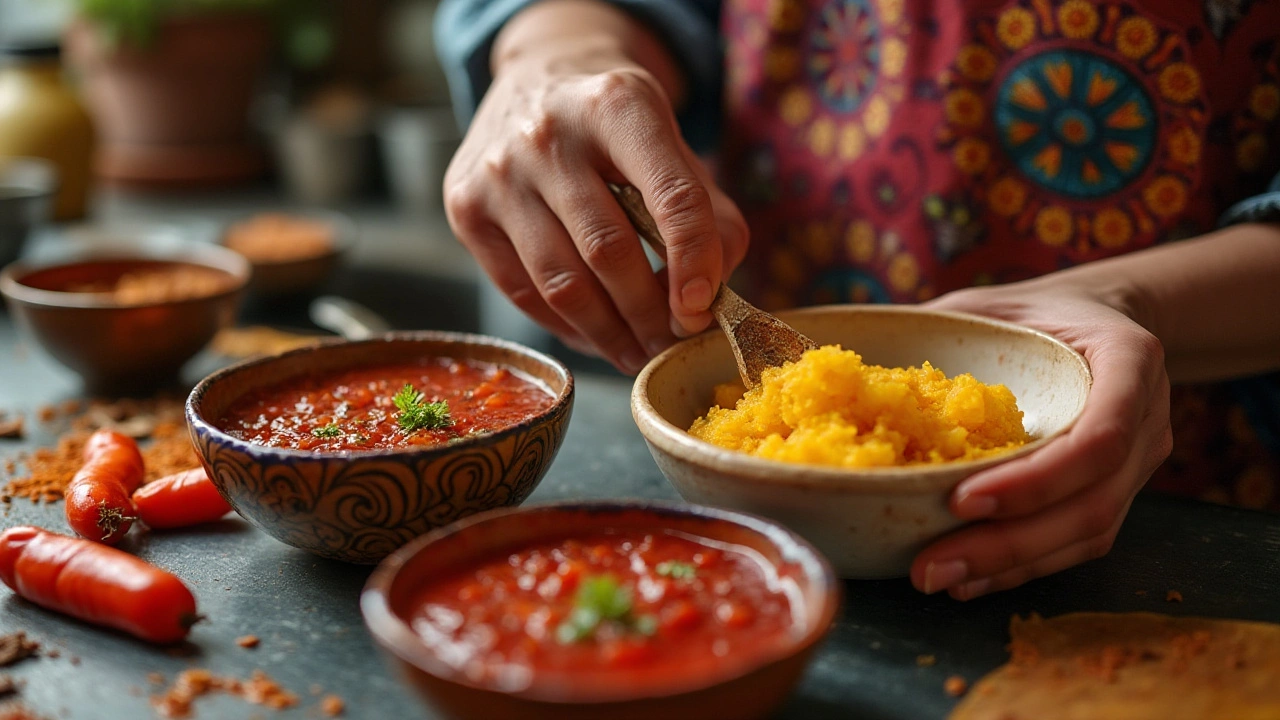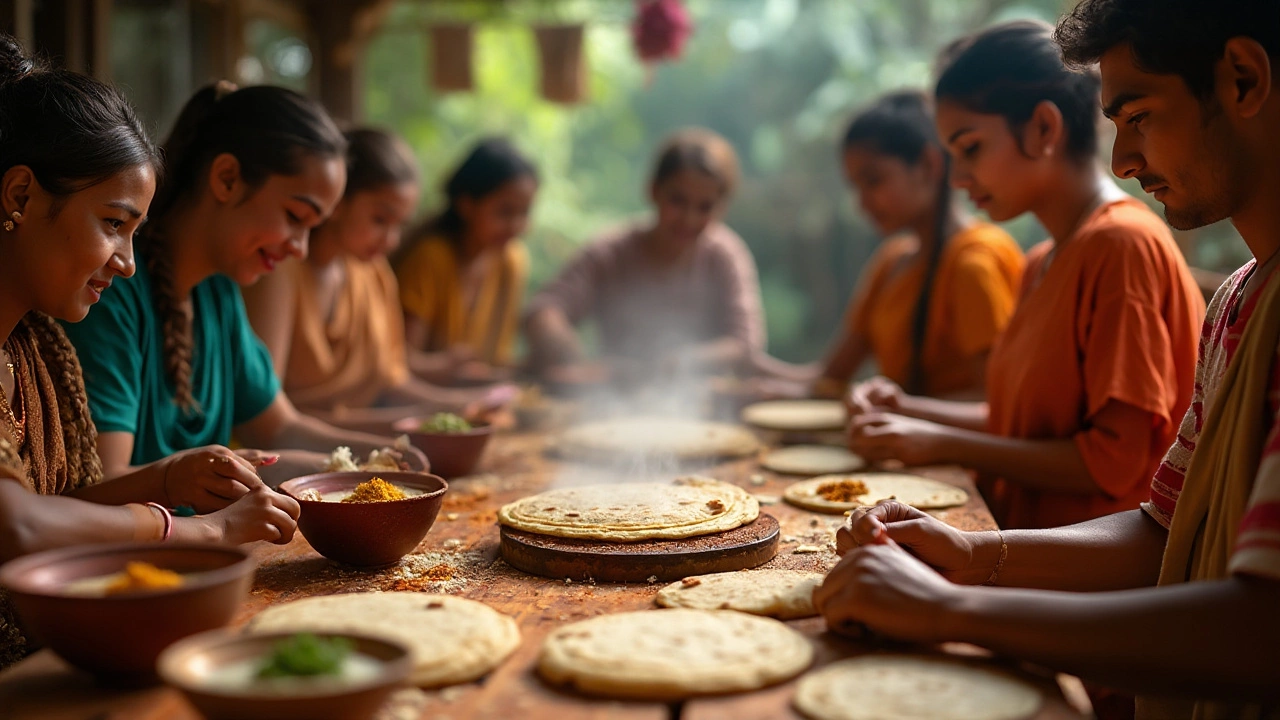November 2024 Indian Food Tips & Recipes – Sweets, Breakfast, Roti & More
If you’re scrolling through November’s food posts, you’ll notice a mix of sweet cravings, morning meals, and kitchen hacks. First up, sugar isn’t just a sweetener; it’s the backbone of classic Indian desserts. Whether you’re making gulab jamun, peda, or a new twist, understanding how sugar shapes texture and flavor can turn a simple treat into a crowd‑pleaser.
Morning bites across India
Delhi’s breakfast scene pops up next. Think crispy aloo paratha, tangy poha, and street‑side samosa chaat. The city blends tradition with fast‑paced life, offering quick fixes that still pack bold flavors. Want to bring that vibe home? Grab a few ready‑to‑cook spices, throw in a dash of yogurt, and you’ve got a breakfast that feels authentic without the rush.
Roti, oil, and tasty spreads
Roti lovers, here’s a game‑changer: adding oil at the right stage. Mixing oil into the dough after it rests makes the flatbread softer and easier to roll. It’s also a handy trick for keeping the rotis fluffy when you’re cooking for a crowd. While you’re tweaking dough, consider swapping red onion marmalade for chutney. Both are tangy, but marmalade leans sweeter, chutney gets a spicy kick. Try each on a warm roti to see which matches your palate.
Spice aficionados will love the tandoori masala alternatives. When you run out of the ready mix, blend cumin, coriander, paprika, and a pinch of fenugreek. This DIY combo mimics the smoky depth of traditional tandoori without hunting for the exact brand. It works great on chicken, paneer, or even roasted veggies, giving you the same bold taste in a pinch.
Safety and freshness matter too. Eating salads in India can be safe if you follow a few steps: wash veggies with clean water, use a splash of lemon, and avoid pre‑cut mixes from unreliable sources. Simple tips keep your salads crisp and worry‑free, letting you enjoy the crunch without a second thought.
Finally, a quirky look at hamburgers in India shows how global foods adapt locally. While they’re legal in most places, you’ll often find beef‑free versions to respect cultural preferences. Knowing these nuances helps you navigate menus, whether you’re ordering in a metro city or a small town.
All these nuggets – sweet sugar basics, Delhi breakfast hacks, roti oil timing, onion spread swaps, tandoori spice DIY, salad safety, and burger culture – give you a solid toolbox for November cooking adventures. Grab the ingredient, try the tip, and share the results. Indian food is all about flavor, tradition, and a dash of creativity, so keep experimenting and enjoy the journey.
Discover the Key Ingredient in Delicious Indian Sweets
Indian sweets, known for their exquisite flavors and rich textures, often revolve around one key ingredient: sugar. Different types of sweets have unique variations, yet sugar remains a dominant player in the equation, providing sweetness and structure. From the humble gulab jamun to the luxurious peda, understanding the role of sugar highlights its essential part in Indian confectionery. Explore diverse recipes and learn how this simple ingredient brings magic to celebrated treats.
Discovering the Delightful Breakfasts of New Delhi: A Culinary Journey
New Delhi, a city that truly captures the heart of India’s diverse culture, boasts a wide variety of breakfast options that cater to both traditional and modern tastes. From flavorful street food to comforting home-cooked dishes, the capital city offers a breakfast spread that is as rich and varied as its history. Learn about some of the typical breakfast items that locals savor as they begin their day, and discover tips to enjoy these delights as a visitor. Whether you're in the mood for spicy, savory, or a hint of sweet, New Delhi’s breakfast scene promises an unforgettable start to the day.
The Perfect Timing for Adding Oil to Roti Dough
Adding oil to roti dough at the right time can make a significant difference in texture and flavor. Whether you're aiming for soft, fluffy rotis or something with a bit more bite, understanding the role of oil is key. This article explores the best practices for incorporating oil into your roti dough, offering valuable tips and interesting facts to elevate your cooking skills. We'll delve into the science behind how oil affects dough elasticity and moisture retention to help achieve perfect results.
Understanding the Difference: Red Onion Marmalade vs. Chutney
Exploring whether red onion marmalade is the same as chutney, this article delves into the distinctions and commonalities between the two. Both versatile and flavorful, these condiments enhance a variety of dishes. Learn about their unique ingredients, preparation methods, and the best ways to use them in your kitchen. This guide will provide tips and insights for enhancing your culinary skills with these savory spreads.
Best Alternatives for Tandoori Masala in Chicken Recipes
Delve into the world of tandoori chicken alternatives, exploring the diverse spices you can use when tandoori masala is out of reach. Discover simple yet effective substitutes, learn how to blend spices at home, and understand their individual flavor profiles. This guide aims to equip you with the knowledge to whip up a flavorful dish even without the traditional tandoori masala. From accessible pantry staples to DIY spice mixes, turning ordinary chicken into a feast has never been easier.
Discover the World's Best Breakfasts: Exploring India's Morning Delights
Breakfast is often called the most important meal of the day, and around the world, countries take pride in their unique morning spreads. This article seeks to determine which country offers the best breakfast, with a particular focus on India's diverse morning offerings. From spicy, savory dishes to sweet treats, Indian breakfasts vary widely by region and are packed with flavor. Dive into the cultural and culinary significance of breakfast in India and discover how it compares to other countries.
Is Eating Salad in India Safe? Tips and Recipes for Salad Lovers
Salads are often considered a healthy meal option, but concerns about their safety in India can arise due to factors such as water quality and produce handling. This article explores the safety of consuming salads in India and provides helpful tips to ensure a healthy dining experience. Learn how to prepare delicious and safe Indian salads using fresh ingredients and proper hygiene practices. Discover the balance between enjoying a nutritious meal and being mindful of local conditions.
The Myth of the Perfect Round Roti: Embrace Imperfections in Roti Making
Why do we strive for perfect roundness in rotis, and does it truly matter? As home cooks from different cultural backgrounds explore their culinary heritage, the pursuit of a round roti often overshadows the actual essence of this staple. While the circular shape might carry a certain aesthetic appeal and tradition, the secret to a good roti lies more in its texture and taste. Many practical tips can help you create delicious rotis, regardless of their form.
Understanding the Legality and Culture of Hamburgers in India
In India, hamburgers have carved a niche in the culinary landscape amid cultural and religious diversity. While not traditionally part of Indian cuisine, they are gaining popularity in urban areas and influenced by global fast-food chains. The legality of selling hamburgers is nuanced, influenced by regional regulations and cultural norms. This article explores the legal landscape, cultural acceptance, and factors to consider when enjoying or selling hamburgers across different parts of India.
Terms of Service
Terms of Service for Southern Spice Mart (dakshinmart.in) — your trusted source for authentic South Indian recipes and culinary insights. Read our legal terms for website use and content guidelines.
Privacy Policy
Southern Spice Mart's Privacy Policy explains how we collect and use anonymous data via cookies and analytics. No personal information is stored. Compliant with Indian and global standards.








